Natural forest regeneration is hailed as a cost-effective way to restore biodiversity and sequester carbon.
Natural forest regeneration is hailed as a cost-effective way to restore biodiversity and sequester carbon. However, the fragmentation of tropical forests has restricted the movement of large birds limiting their capacity to disperse seeds and restore healthy forests.
New research from the Crowther Lab at ETH Zurich illustrates a critical barrier to natural regeneration of tropical forests. Their models – from ground-based data gathered in the Atlantic Forest of Brazil - show that when wild tropical birds move freely across forest landscapes, they can increase the carbon storage of regenerating tropical forests by up to 38 percent.
Birds Seed Carbon Potential
Fruit eating birds such as the Red-Legged Honeycreeper, Palm Tanager, or the Rufous-Bellied Thrush play a vital role in forest ecosystems by consuming, excreting, and spreading seeds to as they move throughout a forested landscape. Between 70 to 90 percent of the tree species in tropical forests are dependent on animal seed dispersal. This initial process is essential for allowing forests to grow and function. While earlier studies have established that birds are important for forest biodiversity, researchers at the Crowther Lab now have a quantitative understanding of how they contribute to forest restoration.
Read more at ETH Zurich
Photo Credit: annaluizaao via Pixabay




